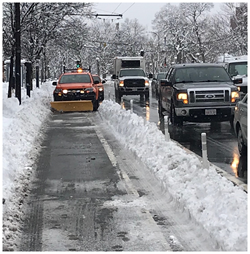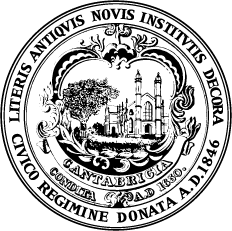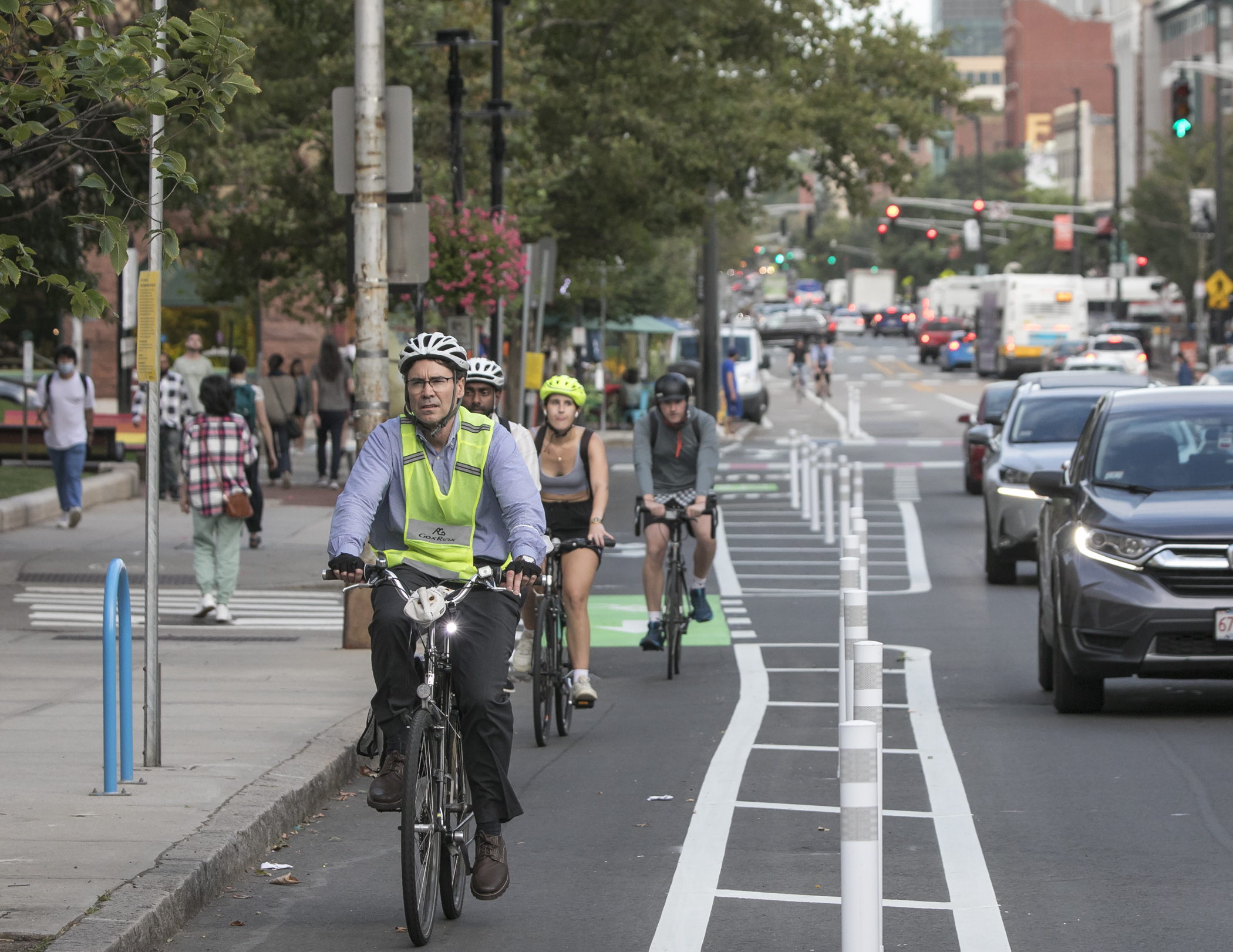Why are some bike lanes separated with flex posts, and some are fully constructed?
Separated Bike Lanes in Construction Projects
Cambridge’s Five Year Sidewalk and Street Reconstruction Plan lists upcoming reconstruction projects. The CSO requires DPW to construct separated bike lanes when streets are redesigned and reconstructed if the Cambridge Bike Plan requires greater separation on those streets.
To meet the timelines of the CSO, we cannot fully construct every separated bike lane project. Full Construction projects begin with planning and continue with design, and public engagement before roadway work commences. This process spans several years. Full construction projects involve more than just bike lanes and may include:
- utility upgrades
- sewer separation
- accessibility updates
- stormwater management
- adding street trees
- improving green infrastructure
- upgrading traffic signals and making changes to signal timing
- improving transit access
- moving curblines
- repaving streets and sidewalks
- changes to markings and stencils on the street
- new signage
- changes to parking and loading regulations
- adding elements like sidewalk-level bike lanes, raised crossings, or crossing islands.
Quick-Build Separated Bike Lanes
Because Cambridge can undertake a limited amount of reconstruction projects at a time, many Cycling Safety Ordinance projects are “quick-build” projects. This means we are not altering the attributes of the road. Quick-build projects allow us to make changes to our streets more rapidly (within weeks or months) and to make adjustments even after a design is installed.
Quick-build projects may include:
- Repaving the street
- Changes to markings and stencils on the street
- Flex-posts and other permanent barriers to separate bike lanes from traffic
- New signage
- Changes to parking and loading regulations
- Traffic signal adjustments.
What do you use to separate quick-build bike lanes from the rest of the street?
The City uses flex posts to separate bike lanes from parking and general travel lanes in quick-build projects.
Quick-build bike lanes are usually against the curb at street level. If there is parking, the parking will be located between the bike lane and the traffic lane. We call this “floating parking.”
Between the bike lane and the parking/travel lane, there is a hatched “buffer” area. In most of the City, there are flex posts inside this buffer area. In several places, the City is piloting concrete curbs between bike lanes and parking or general travel lanes. You may notice these on Brattle Street and a section of Garden Street. Staff are observing how these work before deciding whether to use them elsewhere in the City.
What decisions do you make about the design of the quick-build separated bike lane itself?
The Cycling Safety Ordinance sets very clear standards for what qualifies as a quick-build separated bike lane. Quick-build bike lanes must be separated from motor vehicle traffic by a flexible delineator or similar separator, and these must remain in place year-round. There may be gaps in the separation to accommodate crosswalks, curb cuts, accessibility/disability parking spaces, intersections, and bus stops.
These restrictions mean that quick-build separated bike lanes are against the curb (next to the sidewalk). If there is parking, it is “floating” between the bike lane and the travel lane, and there are flex posts or another vertical barrier between parking spaces and the bike lane.
With these standards in place, we generally know what a bike lane will look like going into a project. In some cases, we can choose between two bike lanes – one on each side of the street – or a single, wider two-directional bike lane on one side of the street. If we consider a two-direction bike lane (like on Brattle Street), we look very carefully at the surrounding area, including how many vehicles are turning across the bike lane.
What else does the City do while installing quick-build separated bike lanes?
When we install quick-build separated bike lanes as part of the CSO, we use it as an opportunity to make other safety improvements on the street. Our safety improvement projects aim to improve our streets for everyone using them – that includes pedestrians, transit-riders, people with accessibility needs, and drivers as well as pedestrians.
Depending on the street, improvements may include:
-
repaving the street
-
adding accessible curb ramps
-
adding more accessible/disability parking spaces
-
adding extra space around crosswalks to make them more visible
-
adding painted pedestrian crossing islands
-
moving bus stops to space them more efficiently or make them easier to board
-
adding dedicated bus lanes
-
visually narrowing the street to discourage speeding
Many quick-build separated bike lane projects require removing some parking. Why is parking sometimes lost and what factors are weighed in determining parking changes?
Parking on both sides of the street plus separated bike lanes do not always fit in the same segment of the street. When we add the bike lanes, sometimes we need to remove parking. In developing the design of a project, we conduct outreach and engage with community members and local businesses to determine where parking is most needed, and what types of regulations we should have for those parking spaces.
The design of separated bike lanes (including location of floating parking) is constrained by existing features on the street.
These include:
Width of the street: We are challenged to fit separated bike lanes, travel lanes, and parking lanes in the existing space between the curbs of the street. Our standards are:
- ~10 feet minimum travel lanes (10.5 feet for streets with a lot of buses and trucks)
- ~7 feet minimum parking lanes (8 feet for loading zones and trucks)
- ~8 feet minimum for quick-build separated bike lanes, including flex posts (to fit street cleaning equipment, keep cyclists out of the “door zone” of parked cars, and fit diverse bike types
Often, when we add the minimum widths of these elements together, we have to eliminate a parking lane to fit within the street width.
Safety and visibility: We restrict parking around crosswalks, curb cuts, and corners so that drivers’ view of the crosswalk, bike lane, and side streets aren’t blocked by parked cars. This is called “daylighting” to improve safety and reduce the likelihood of crashes.
Driveways and curb cuts: The number of curb cuts, side streets, and driveways impact the number of parking spaces we can fit on one side of the street. More cut cuts or driveways means there’s less space for parking on that side of the street.
How do you make choices on quick-build project design?
When we have flexibility in the project design, we use community feedback to help us make a choice. Often, these choices include what side of the street parking should go on or what the regulations for remaining parking spaces should be
To make these decisions, we solicit input from residents and local businesses on their parking needs. For most projects, we share a draft design, adjust that design based on community input, share a near-final design, and then solicit more feedback for final changes. We ask businesses about their specific parking needs, including loading zones, and take these into account in the final design.
It is very difficult to come up with a decision that meets everyone’s needs and requests, but by soliciting input from as many stakeholders as possible, we can make informed decisions about how to lay out the project.
After a project is installed and we have given the public time to get used to the new design, we may consider additional changes to a quick-build project.
How does public input shape quick-build separated bike lanes?
Over time, the City has developed a standard process for quick-build separated bike lane and safety improvement projects. In general, each CSO quick-build project goes through four engagement phases:
- Phase 1: Introduction. The City introduces background and goals for a project and requests feedback on existing conditions.
- Phase 2: Design Feedback. Once the engineering and design limitations are understood, the City develops a draft design or design options and requests feedback on the design(s). The specific feedback we’re looking for is different for different project. Questions could include:
- Which side of the block should parking be on?
- What should parking regulations be (e.g., loading zones, meters, accessible spaces, permit-only spaces)?
- Should we move the bus stop?
- Phase 3: Final Feedback. The City updates the design based on input from Phase 2 and requests more comments before finalizing the design.
- Phase 4: Installation and Post-installation. The City share information to businesses and residents about the final design, the installation schedule, what changes to expect, and how to navigate changes.
Occasionally, we will amend this process to tailor it to the project’s unique needs.
The City uses a variety of tools to receive feedback. Past tools have included online surveys and feedback forms, in-person open houses and pop-ups, feedback maps, online community meetings, one-on-one meetings with business owners and neighborhood groups, emails, and phone calls.
What happens after a quick-build separated bike lane project is installed?
The City monitors CSO projects after installation, and can make some adjustments to address issues. Immediate changes might include additional signage and updates traffic signal timing. After giving the public time to get used to the new design, we may consider additional changes, such as changes to parking regulations. For example, in the past, we have changed metered spaces into accessible spaces and “no stopping” areas into loading zones.
Each quick-build Cycling Safety Ordinance project undertaken by the Traffic, Parking, and Transportation Department will undergo an evaluation. The purpose of these evaluations will be to determine:
- Whether projects are advancing the City’s safety, health, and climate goals.
- How projects are advancing the goals of the Cycling Safety Ordinance.
In our evaluations, we will establish objective measures of effectiveness of the CSO projects. The evaluations will assess the tradeoffs of each project by comparing benefits and costs. If the benefits are greater than the costs, the project is a success. Learn more about the evaluation framework and schedule here.
How do you remove debris and snow from separated bike lanes?
 The City's Department of Works can clean debris out of bike lanes with street sweepers and includes bike lane plowing in their plowing schedule each winter. We design our quick-build separated bike lanes so that they are wide enough to fit small plows and street sweepers.
The City's Department of Works can clean debris out of bike lanes with street sweepers and includes bike lane plowing in their plowing schedule each winter. We design our quick-build separated bike lanes so that they are wide enough to fit small plows and street sweepers.
DPW owns several 4- to 6-foot wide snow plows that are small enough to fit in separated bike lanes, and a few of the bike lanes are wide enough to be maintained with a pick-up truck with an 8-foot plow. DPW also spreads salt and brine on bike lanes to prevent icing.
Residents can report icy or snowy bike lanes in SeeClickFix at this link.
What is the CSO Advisory Group?




 The City's Department of Works can clean debris out of bike lanes with street sweepers and includes bike lane plowing in their plowing schedule each winter. We design our quick-build separated bike lanes so that they are wide enough to fit small plows and street sweepers.
The City's Department of Works can clean debris out of bike lanes with street sweepers and includes bike lane plowing in their plowing schedule each winter. We design our quick-build separated bike lanes so that they are wide enough to fit small plows and street sweepers.